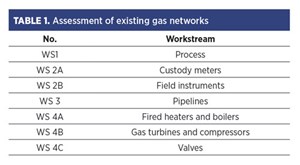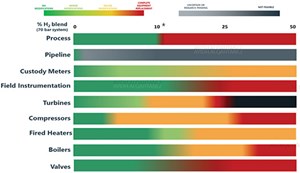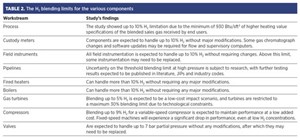Articles
A feasibility study: Decarbonization through H2 fuel
IINFRASTRUCTURE DISTRIBUTION
A. AL-QAHTANI, W. AL- BLAIES, A. AL-RUMAIH and M. RITHAUDDEEN, Saudi Aramco, Dhahran, Saudi Arabia
The author’s company’s decarbonization initiatives have been implemented to reduce carbon emissions and achieve future net-zero aspirations. This aligns with Saudi Arabia’s Green Initiative to cut domestic carbon output through a carbon circular economy roadmap by 2060.
One method explored was decarbonizing domestic gas networks by replacing natural gas with hydrogen (H2) to reduce emissions from industrial natural gas networks. This is achievable by creating a blended stream within the existing gas network. The addition of H2 decreases the carbon content, resulting in reduced carbon dioxide (CO2) emissions when used as a combustion fuel at the end user’s facility. Upstream blue or green H2 production methods must be employed to gain the decarbonization benefits of H2-blended gas.
As a result, a feasibility study was performed to evaluate methods of H2 blending. This study presented multiple options at various cost levels, leading to varying degrees of decarbonization benefits.
The assessment focused on the existing gas network—every gas network is unique in terms of the design limitation and type of end users silicification. As shown in FIG. 1, several workstreams were evaluated and summarized in TABLE 1.
The study provided two options: blending H2 directly into the grid, and blending H2 at the end user’s battery limit by supplying H2 through a dedicated pipeline.
Blending H2 directly into the grid was studied based on various components, which included process, pipelines, custody meters, field instrumentation, gas turbines, compressors, fired heaters, boilers and valves. Seven cases were studied covering a range of injection percentages for H2 to assess the impact on the network.
All components showed an acceptance limit of up to 5%–10%, except pipelines that showed a lower limit due to high-grade materials operating at high pressure. The same challenge has been encountered elsewhere in the oil and gas industry when operating a high-pressure natural gas network. It is worth noting that many of the benchmarked studies conducted on relatively low-pressure gas networks showed marginal flexibility in tolerating an increased blended H2 reaching up to 5%–10% concentration limits. Further research and testing through joint industrial programs (JIPs) are ongoing to provide insight into the material H2 embrittlement with detailed validation and qualification requirements for the industry.
Multiple local network components were assessed to determine the expected limits. The study’s findings indicated there was no common limiting H2 value that is valid for all parts of the natural gas network infrastructure. The blending limits for the various components are shown in FIG. 2 and summarized in TABLE 2.
The illustrated results and findings are related to the first option of injecting H2 into the natural gas grid. Conversely, blending H2 at the end-user’s battery limit is a viable method to mitigate the constraints. In this case, a dedicated low-pressure H2 transmission pipeline with properly qualified materials will be utilized to deliver 100% H2 to end users responsible for making the right blend at their battery limits. The H2 source could be from blue H2 production (steam methane reforming with carbon capture and storage) and/or green H2 (renewable power with electrolysis).
Takeaway. Blending H2 into the entire natural gas system presents complexities with uncertain risks on pipeline metallurgy and constraints to some end users that use this gas as a feedstock. It is not the most cost-effective option for decarbonization vs. the dedicated H2 network option, which offers a significantly lower cost per ton and enables targeting selected end users most suited for decarbonization via H2 fuel usage.
Alternatively, investing in a standalone H2 network will minimize the cost required to build larger H2 production facilities, avoid expensive gas network modifications and allow the flexibility to deliver H2 at higher concentrations at the end user’s battery limits. Therefore, to further develop the dedicated H2 network that can supply blue and green H2, a more comprehensive assessment of end users should be undertaken to ensure feedstock users are not impacted.
The gas turbine market should be monitored for developments in the limits of H2 in existing gas turbine machines. There is also a potential for increased H2 concentrations without impacting the modification cost, leading to increased decarbonization levels and expanding H2 supply. Operational expenditure reduction can be capitalized through increased investments in green energy projects across Saudi Arabia, reducing the overall cost of renewable power for H2 production from electrolysis over the long term.H2T
AYIDH AL-QAHTANI is a Process Engineer in the Energy Transition Engineering department for Saudi Aramco.
WAEL F. BLAIES is a General Supervisor in the Energy Transition Engineering department for Saudi Aramco.
ABDULLAH M. AL-RUMAIH is a Principle Professional in the Consulting Services department for Saudi Aramco.
MEGAT AHMAD RITHAUDDEEN is a Gas Process Engineering Specialist in the Process & Control Systems department for Saudi Aramco.





